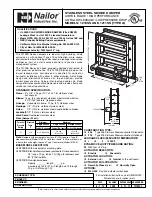
MS4120F; MS4620F; MS8120F; S2024-F; S20230-F FAST-ACTING, TWO-POSITION ACTUATORS
5
63-2584—10
Fig. 4. Mounting shaft coupling to actuator opposite side.
Mounting
CAUTION
Device Malfunction Hazard.
Improper shaft coupling tightening causes device
malfunction.
Tighten shaft coupling with proper torque to prevent
damper shaft slippage.
CAUTION
Actuator Damage Hazard.
Using actuator as shaft bearing causes device
damage.
Use actuator only to supply rotational torque. Avoid
any side loads to actuator output coupling bearings.
To mount actuator, proceed as follows:
1.
Place actuator over damper shaft; and hold mounting
bracket in place. See Fig. 5.
2.
Mark screw holes on damper housing.
3.
Remove actuator and mounting bracket.
4.
Drill or center-punch holes for mounting screws (or use
no.10 self-tapping sheet metal screws).
NOTE: If necessary, use a field-fabricated steel base
plate secured with sheet metal screws.
5.
Turn damper blades to desired normal (closed) position.
6.
Place actuator and mounting bracket back into position
and secure bracket to damper box with sheet metal
screws.
7.
Using 10 mm wrench, tighten shaft coupling securely
onto damper shaft using minimum 120 lb-in., maximum
180 lb-in. torque.
Fig. 5. Mounting actuator to damper housing.
M20054A
ENSURE THAT MOUNTING ASSEMBLY PREVENTS ACTUATOR
ROTATION AND ALLOWS ACTUATOR TO FLOAT ALONG
INDICATED AXIS. WHEN TOO TIGHT, THE RESULTING BINDING
CAN DAMAGE THE ACTUATOR OR REDUCE TORQUE OUTPUT.
ACCESSORY MOUNTING BRACKET IS NOT SUPPLIED WITH
THE ACTUATOR.
1
2
1
2
M20055



























